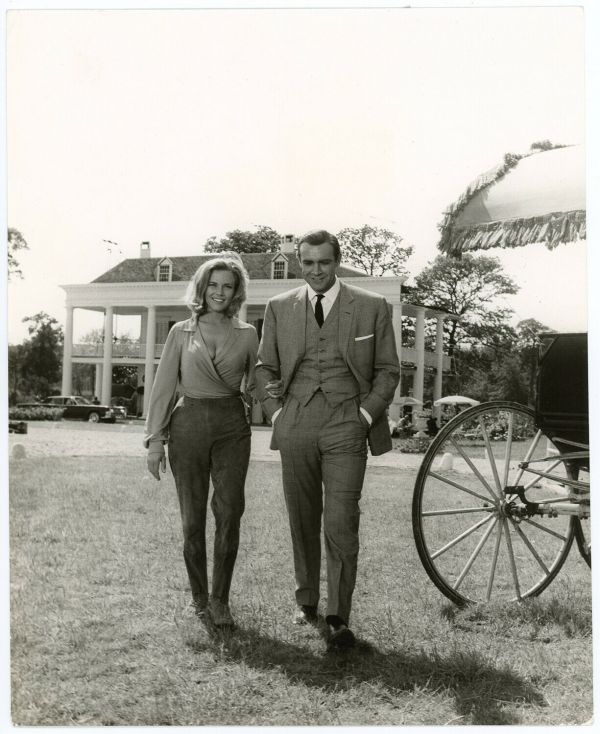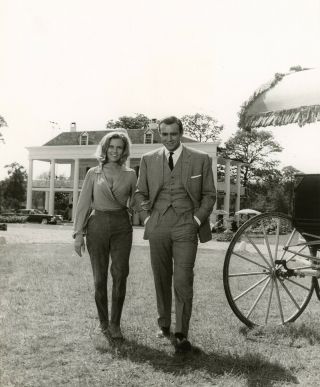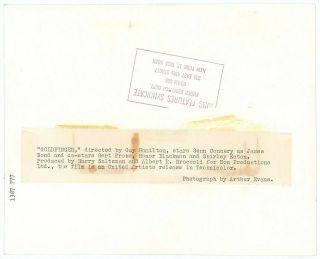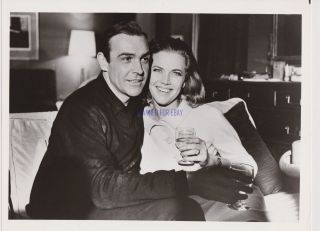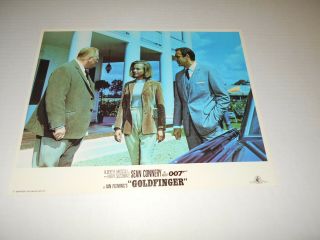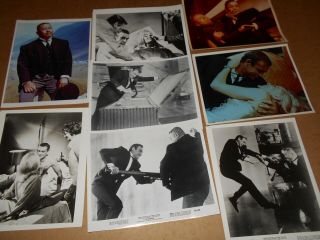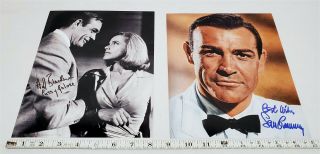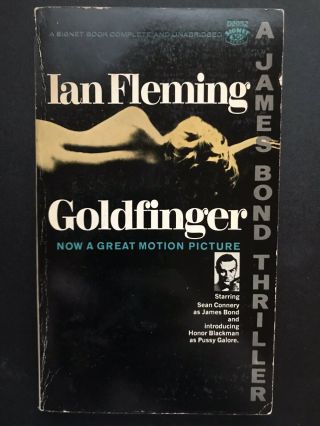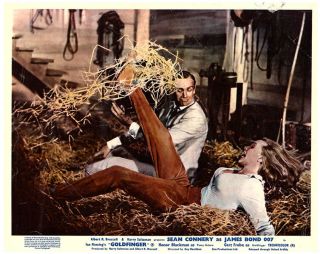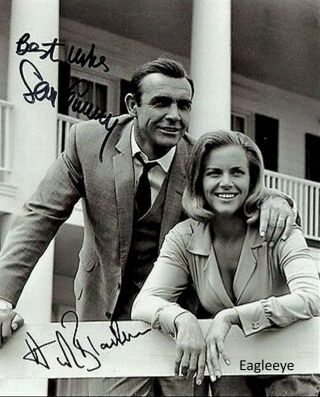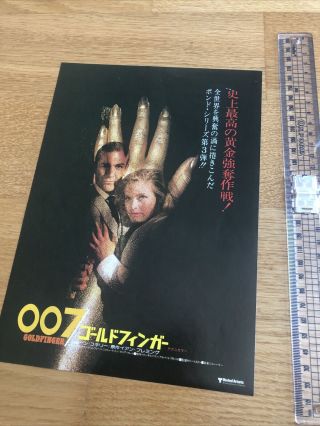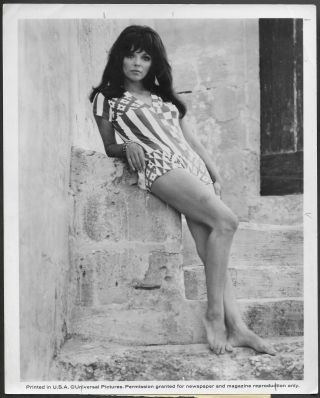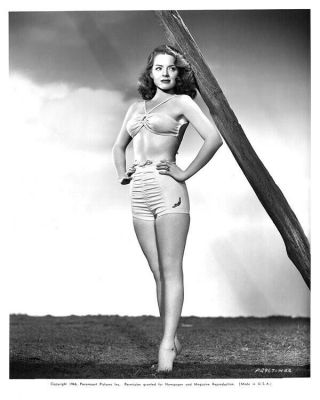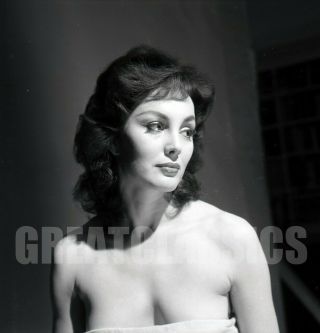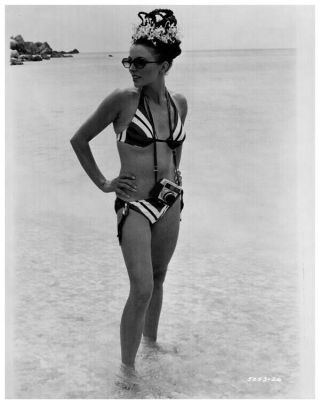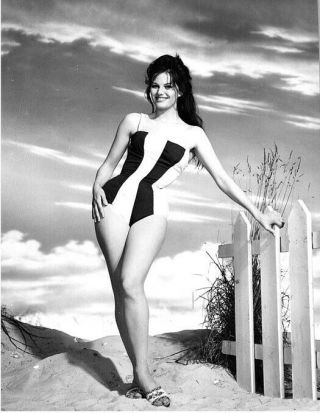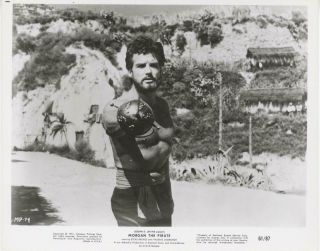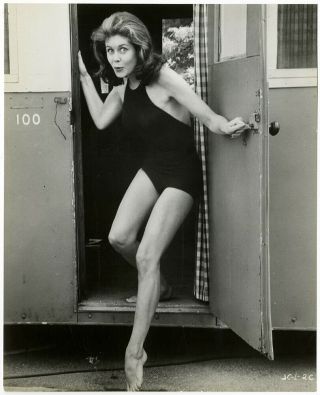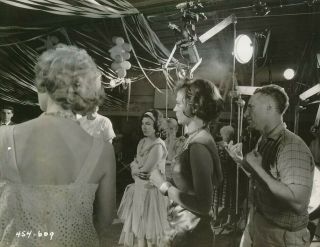James Bond Spy Sean Connery & Honor Blackman Goldfinger Photograph 1964
Item History & Price
"Goldfinger" is the third installment in the James Bond series produced by Eon Productions. Many of the elements introduced in the film appeared in many of the later James Bond films, such as... the extensive use of technology and gadgets by Bond, an extensive pre-credits sequence that stood largely alone from the main storyline, multiple foreign locales and tongue-in-cheek humor. "Goldfinger" was the first Bond film to win an Oscar (for Best Sound Editing) and opened to largely favorable critical reception.
Photograph measures 7.5" x 9.25" without margins on a glossy single weight paper stock. King Features Syndicate ink stamp and paper caption on verso.
Guaranteed to be 100% vintage and original from Grapefruit Moon Gallery.
More about Honor Blackman:
Lovely, seductive, and absolutely able to take care of herself in a jam, Honor Blackman helped to establish the tough girl persona that would be adopted and honed in later decades by successors like Milla Jovovich and Kate Beckinsale. The London native moved from stage to screen for roles in features like "Quartet" (1948) and "A Night to Remember" (1958), but would first find genuine fame on television with the droll adventure series "The Avengers" (ITV, 1961-69). As leather-clad tough girl Cathy Gale, Blackman wowed viewers with her femininity and physicality, and that appealing combination led her to be cast in the classic James Bond film "Goldfinger" (1964) as the memorably monikered Pussy Galore. Although many of the female leads in 007 adventures fell victim to the so-called "Bond Girl Curse, " Blackman's career moved along in the wake of "Goldfinger, " though the majority of her subsequent films proved to be minor and/or forgettable. She instead found satisfaction working on the stage in productions like "Wait Until Dark" and made periodic appearances on both American and British television. Although Blackman never became a top-tier star, she essayed two iconic characters and proved to be a dependable and desirable performer, expanding her already impressive résumé with assignments right up through her mid-eighties.
Honor Blackman was born on Dec. 12, 1927 in London, England. Blackman's childhood was marred by a difficult relationship with her father, a World War I veteran-turned-civil servant. A strict authoritarian, he was especially hard on both his homemaker wife and daughter, who found him unreasonably demanding. Verbally abusive to Honor, he also occasionally beat her with a belt and rarely offered any sort of praise or affection. On the plus side, however, he did offer to pay for either a bicycle or elocution lessons. Already interested in performing, thanks to her participation in her school's drama class, Blackman chose the latter and shed her Cockney accent in the process. Her father also insisted that she study self-defense and the dexterity Blackman developed from her judo classes proved invaluable in later life.
After her father hit her in the face for wearing lipstick, Blackman moved out at age 18, staying at first with a friend's family and then on her own. Fortunately, Blackman's studies at the Guildhall School of Music and Drama paid off and acting roles soon started to come. During that period, she also married her first husband, businessman Bill Sankey. Blackman made her film debut in the British drama "Fame is the Spur" (1947) and quality work opposite Dirk Bogarde in the acclaimed anthology picture "Quartet" (1948) announced her talents to the motion picture world. She also earned a supporting part in the Robert Taylor and Elizabeth Taylor vehicle "Conspirator" (1949), an MGM production shot in England. Just as her career was gaining momentum, Blackman discovered she was pregnant and opted to have an abortion, an illegal procedure in England at the time.
She went on to appear in such notable movies as "So Long at the Fair" (1950) and "The Rainbow Jacket" (1954), but her marriage to Sankey came to an end in 1954, the result of extensive jealousy on his part and an unhappy reminder of the behavior that had soured Blackman's relationship with her father. The strain contributed to a nervous breakdown and she spent a month in a psychiatric facility. She was soon able to resume her career and landed the female lead in "A Night to Remember" (1958), the Rank Organization's celebrated drama about the sinking of the RMS Titanic. She also gained some small screen experience on programs like "Probation Officer" (ITV, 1959-1962) and "The Four Just Men" (ITV, 1959-1960). In 1961, Blackman wed her second husband, actor Maurice Kaufmann, who had a lengthy career in British films, television and stage productions, and the couple went to adopt two children.
On the heels of that big life event, Blackman was cast as one of her most beloved characters. In 1962, she joined "The Avengers" (ITV, 1961-69) as Cathy Gale, the very able partner of suave John Steed (Patrick MacNee). Looking most fetching in a catsuit and able to best virtually any opponent in a fight, thanks to Gale's mastery of judo, the impressively lithe Blackman was an instant success and soon found herself a popular pin-up girl. During her second season on the show, she and MacNee even recorded a comic single called "Kinky Boots." The Cathy Gale catsuit look later became a standard fashion accessory for successors like Milla Jovovich and Kate Beckinsale in their respective genre film outings. A newly famous Blackman returned to the silver screen as the Goddess Hera in the fantasy adventure "Jason and the Argonauts" (1963), but her career possibilities in that arena would soon accelerate considerably.
At that point, "The Avengers" had yet to play on American television, but James Bond producer Albert "Cubby" Broccoli knew from her charismatic work on the program that Blackman would be a perfect addition to the 007 universe. Thus, she was given the opportunity of being cast in "Goldfinger" (1964), one of the series' finest entries; unfortunately, she was also saddled with the single most - for obvious reasons - infamous "Bond Girl" name in the 007 universe: Pussy Galore. Embarrassing moniker aside, the ever lethal Blackman made for one of the series' most memorable leading ladies and proved to be a novel challenge for Sean Connery's suave agent. Her brand of femme fatale was still fairly novel at the time, but would eventually become a staple of action movies in the decades to come. While the sexism of "Goldfinger" was very much of its time - including the belief that even the seemingly lesbian Galore was not immune to Bond's seductive powers - Blackman still became a favorite of feminists. Atypically mature at age 37 when was cast, Blackman also proved to be one of the few Bond Girls to benefit from the series' wide exposure.
Her career was not without its rough passages, however. Blackman departed from "The Avengers" after two years in favor of more film work, though limp formula fare like "The Secret of My Success" (1965) did little to achieve that goal. She capitalized on her new image with Honor Blackman's Book of Self Defense (1965) and starred in a West End production of "Wait Until Dark, " but a second go-around with Connery in the European Western "Shalako" (1968) proved disappointing. Following equally limp efforts like "Lola" (1970) and the horror thriller "Fright" (1971), it seemed like Blackman's motion picture career would not amount to much in the long run.
After finishing her role in the awful Dean Martin western "Something Big" (1971), Blackman stepped away from movies for a few years and concentrated on television, guesting on programs like "Columbo" (NBC, 1971-2003). Her marriage with Kaufmann ended in 1975, but they remained friends. She returned to the film world in "To the Devil a Daughter" (1976), one of Hammer's final horror efforts and a lesser one at that. On the other end of the scale was Radley Metzger's sly and well produced "The Cat and the Canary" (1978), an affectionate homage to more old-fashioned, less explicit scare fare. Globe-hopping television engagements in the miniseries "Lace" (ABC, 1984) and the original run of "Doctor Who" (BBC, 1963-1989) alternated with stage work in productions like "Nunsense." She also re-entered the world of episodic television in the cast of "The Upper Hand" (ITV, 1990-96), a U.K. comedy inspired by the popular Tony Danza sitcom "Who's the Boss?" (ABC, 1984-1992).
By now in her seventies, Blackman's schedule slowed down somewhat, but certainly did not come to a standstill. After a 20-year absence from cinema, Blackman co-starred in the horror thriller "Tale of the Mummy" (1998) and essayed a supporting role in the Renée Zellweger hit "Bridget Jones's Diary" (2001) as Penny Husbands-Bosworth. On the personal front, Blackman expressed her belief that the time for a monarchy in England had passed. When offered the honor of a C.B.E. (Commander of the Most Excellent Order of the British Empire) in 2001, she stuck by her convictions and turned the designation down.
With finances somewhat tight after the collapse of a pension fund that she had invested in heavily, Blackman continued to work, but was usually able to choose projects of some distinction, including a turn on the legendary soap opera "Coronation Street" (ITV, 1960- ). She also entered into what turned out to be a lengthy run as a spokeswoman for the Marks & Spencer department store chain. In 2005, Blackman's still stunning looks were complimented by Good Housekeeping, which named her "the sexiest woman in her 70s." That same year, she also acted in a touring company of "My Fair Lady" and followed up with "Cabaret, " her first work in a West End production for two decades. Alternating between homes in England and Spain, Blackman remained active into her mid-eighties, appearing in the thriller "I, Anna" (2012) and the comic horror tale "Cockneys vs. Zombies" (2012).
TCM | Turner Classic Movies Biography By John Charles
More about Sean Connery:
Though he was already established as an actor on the rise, Sean Connery blasted into international stardom when he surpassed several other name actors to become James Bond for the first installment of the decades-long spy franchise, "Dr. No" (1962). Suave and debonair, but also deadly, Connery exuded charm and appeal as MI6 agent 007, which helped make "Dr. No" a giant box office hit in both its native England and the United States. He reprised the role a total of seven times in three different decades, including the models for all other Bond films to follow, "From Russia with Love" (1963) and "Goldfinger" (1964). Though he bowed out of the role in 1967 following "You Only Live Twice, " he returned for a big payday with "Diamonds Are Forever" (1971), after which he famously vowed never to play the role again. While he appeared in numerous films in the ensuing years - "Murder on the Orient Express" (1974), "A Bridge Too Far" (1977) and "Time Bandits" (1981) chief among them - Connery had trouble reaching the heights of success he enjoyed as Bond. Going back on his word, he reprised the role one last time for the unofficial Bond movie, "Never Say Never Again" (1983), which was, as usual, a giant box office hit. Connery was primed to take his career to the next level, which he did when he won an Academy Award for his role as a gruff old Irish cop in "The Untouchables" (1987). He followed with a memorable performance as the senior Dr. Henry Jones in "Indiana Jones and the Last Crusade" (1989) while turning in a fine performance as a defecting Russian submarine commander in "The Hunt for Red October" (1990). Though retired following a string of lesser efforts in the 1990s and into the next century, Connery left behind a career of performances that were surprising in both their variety and subtlety, which only assured his place in cinema history as one of its finest and most publicly beloved actors.
Born on Aug. 25, 1930 in Edinburgh, Scotland, Connery was raised in a working class home by his father, Joseph, a factory worker and truck driver, and his mother, Euphamia, a housekeeper. When he was 13 years old, Connery began working as a milkman for St. Cuthbert's Co-operative Society, making deliveries in the morning before going to school. In 1946, he joined the Royal Navy for a 12-year stint, but was forced to leave three years later due to problems with stomach ulcers. After returning to the co-op to deliver milk, he found odd jobs as a lorry driver, laborer, artist's model and coffin polisher. In order to pick up some extra money, Connery began helping out backstage at the King's Theatre in 1951, which soon led to an interest in becoming an actor. That year, he made his debut in the chorus of a London production of "South Pacific" (1951), after which he attempted to become a professional bodybuilder, allegedly placing third in a junior competition for Mr. Universe. Also a solid footballer, Connery was offered a contract to play with Manchester United, but declined in favor of acting. He later reflected that the decision was one of his "more intelligent moves."
Now firmly committed to becoming an actor, Connery moved away from the stage to begin appearing on the screen. Following a small role in the television movie "Lilacs in the Spring" (1954), he received good notices for his leading performance in Rod Sterling's "Requiem for a Heavyweight" (BBC, 1956). Also that year, Connery made his feature debut as a seedy lowlife in "No Road Back" (1956), a crime drama about a blind and deaf nightclub owner (Margaret Rawlings) who finances her son's medical school education by fencing diamonds for a gang of thieves. He earned a bit of a reputation on his next film, "Another Time, Another Place" (1958), which starred Lana Turner as an American war correspondent whose whirlwind romance with a British journalist (Connery) ends in tragedy. While filming the movie, Connery and Turner were captured by photographers going together about town, with the press alluding to a potential real-life love affair. The photos incurred the wrath of Turner's violent mob boyfriend, Johnny Stompanato, who boarded a plane to England and threatened Turner's life. He later arrived on set waving a gun at Connery, warning him to stay away from the actress. Taking no guff from the mobster, Connery wrestled the gun out of Stompanato's hand and knocked him out with a single right cross. The incident was cemented in Hollywood lore when several months later, Turner's 14-year-old daughter, Cheryl, famously stabbed Stompanato to death after witnessing another of his brutal beatings on her mother.
Shortly thereafter, Connery traveled across the pond to make his first film in America, the Walt Disney production of "Darby O'Gill and the Little People" (1959). After appearing in a significant supporting role for the British television adaptation of Leo Tolstoy's "Anna Karenina" (BBC, 1961), he turned to comedy for "On the Fiddle" (1961), joining Alfred Lynch as a pair of accident prone RAF members who are sent on a top secret mission during World War II. He ventured into a more serious side of the war when he joined an all-star cast for the ensemble classic, "The Longest Day" (1961), which told in epic fashion the story about the D-Day Invasion. But in one fell swoop, Connery went from mid-level player to international superstar after beating out many bigger names for the right to play James Bond in the first of many adaptations of Ian Fleming's spy novels, "Dr. No" (1962). With cool sophistication and a touch of humor, Connery transformed the violent character into a warmer personage, which turned the actor into a major 1960s icon. Unknown at the time, the success of the first Bond film helped launch one of the single longest-running franchises in cinema history, spanning several decades - well into the 21st century - and featuring over six actors playing the role. But it would be Connery who would remain the prototypical Bond for the majority of moviegoers.
With the catchphrase "Bond.James Bond" fully enshrined in the cultural lexicon, Connery followed up with his second James Bond film, "From Russia with Love" (1963), which many agreed typified what a Bond film was all about - high-tech gadgetry, femme fatales, suave humor and exhilarating action sequences. Looking back, some considered "From Russia with Love" to be one of the best Bond films ever made. Others, however, pointed to his next turn as 007, "Goldfinger" (1964), as being the best of the bunch. Full of heart-stopping action, flashy gadgets - including an Aston-Martin complete with ejector seat - and an alluring femme fatale dubiously name Pussy Galore, "Goldfinger" surpassed its predecessor to set the standard for all other Bond films to follow. In fact, the movie remained culturally relevant throughout the years, thanks in part to the perhaps the most famous line in the entire series, with Bond asking Auric Goldfinger (Gert Fröbe) while strapped to a table being cut in two by a red laser beam, "Do you expect me to talk?, " and the villain responding, "No, Mr. Bond, I expect you to die."
Of course, Connery managed to make other films besides Bond, though not nearly with as much success. He starred opposite Tippi Hedren in Alfred Hitchcock's last great masterwork, "Marnie" (1964), which he followed with the British-made crime thriller "Women of Straw" (1964) and Sidney Lumet's underrated war drama, "The Hill" (1965). Connery finally returned to the Bond series after a long legal battle between the writers for a fourth movie, "Thunderball" (1965), which was based on one of the best-selling novels in the series. Though well received by critics and a huge success at the box office, "Thunderball" tended to lean toward the more campy side of Bond, while some of the underwater sequences dragged on to interminable lengths. After a failed attempt to break away from his Bond image with the comedy "A Fine Madness" (1966), Connery broke out his Walther PBK for his fifth go-round as Bond in "You Only Live Twice" (1967), which remained as entertaining as the previous movies, though it marked a change from the series' espionage origins to focus more on a save-the-world-from-destruction plot that characterized later series entries.
In 1967, Connery quit the Bond series and was replaced by one-timer George Lazenby for the sixth movie, "On Her Majesty's Secret Service" (1969), which some later said could have epitomized the entire series had Connery decided to again play the role. Temporarily free from Bondage, the actor starred in the forgettable Western "Shalako" (1968) before portraying famed explorer Roald Amundsen in "The Red Tent" (1969). Following a turn as a terrorist leader battling the famed Pinkerton agents in the grim historical drama, "The Molly Maguires" (1970), Connery was enticed out of his Bond retirement with a huge payday to once again play the role in "Diamonds Are Forever" (1971). Full of the gimmickry and catchy one-liners lacking in the Lazenby effort, "Diamonds" received mediocre reviews on its way to becoming yet another big box office hit. Many critics, particularly from later generations, deemed the movie to be one of the worst and most forgettable in the series. Now divorced from Bond - at least for the next decade and a half - Connery was free to explore less heroic characters, which he did as an ex-con masterminding a large heist in Sidney Lumet's slick crime thriller "The Anderson Tapes" (1971).
In "The Offense" (1973), Connery played a police inspector who beats a suspect to death in a child molesting case, which leads to a suspension and a nervous breakdown over the fact he might have his own pederast tendencies. Following a supporting turn as Colonel Arbuthnot in the all-star ensemble "Murder on the Orient Express" (1974), he played a Scandinavian government agent sent to stop a group of terrorists from killing the passengers aboard a hijacked plane in the action thriller "Ransom" (1974). He next teamed up with fellow Brit Michael Caine for a bit of old-fashioned fun in "The Man Who Would Be King" (1975), director John Huston's throwback action adventure from Hollywood days of yore. After playing an older-looking Robin Hood opposite Audrey Hepburn in "Robin and Marian" (1976), Connery joined another all-star cast, which included Anthony Hopkins and Michael Caine, for the World War II epic, "A Bridge Too Far" (1977). Meanwhile, he maintained a steady screen presence in films like "Cuba" (1979), "The Great Train Robbery" (1979) and "Outland" (1981), though none of which seemed to offer anything more than a paycheck.
Following a crucial role as Agamemnon in Terry Gilliam's loopy "Time Bandits" (1981), Connery - who once said he would never play Bond again after "Diamonds Are Forever" - returned one last time to portray 007 in "Never Say Never Again" (1983). Though not an official Bond film, since it was not produced by EON Productions, the film was nonetheless a huge box office hit, even though there was competition from Roger Moore's "Octopussy" (1983). After leaving moviemaking for a couple of years due to the frustration of his making "Never Say Never Again, " Connery made a triumphant returns with his BAFTA-nominated performance as William of Baskerville in "The Name of the Rose" (1986). He next played the immortal Juan Sanchez Villa-Lobos Ramirez in the surprise fantasy hit, "Highlander" (1986). Connery completed his return to top form with his next film, Brian De Palma's crime epic, "The Untouchables" (1987), in which he played Malone, a sly and crafty old Irish cop who helps a young Eliot Ness (Kevin Costner) take down Al Capone (Robert De Niro). Easily stealing the thunder from both Costner and De Niro, Connery earned widespread acclaim and his first-ever Academy Award.
With a renewed star image and an appeal to younger audiences, Connery entered into a fertile period of his career as a beloved personality. Following a misguided appearance as the proud patriarch of a criminal clan in "Family Business" (1989), he had great onscreen chemistry trading barbs as Professor Henry Jones with Harrison Ford in "Indiana Jones and the Last Crusade" (1989), a role that earned him supporting actor nominations at both the Golden Globes and BAFTA awards. He next earned more acclaim as the defecting commander aboard a Russian submarine in "The Hunt for Red October" (1990), a role that earned him yet another BAFTA nomination. After a high-profile cameo as King Richard the Lionhearted in Costner's "Robin Hood, Prince of Thieves" (1991), he portrayed the titular "Medicine Man" (1992), which dealt with the destruction of the Amazon basin and the suggestion that the cure for cancer was chopped away in the madness of development. "Medicine Man" marked Connery's debut as an executive producer, a chore he also performed on "Rising Sun" (1993), in which he teamed with Wesley Snipes in a police drama with international ramifications. Also that year, he reportedly underwent radiation for an undisclosed throat ailment, which sparked media rumors that he had throat cancer. Japanese and South African outlets went as far to say that he was dead. To prove he was alive and well, Connery appeared on "The Late Show with David Letterman" (CBS, 1993- ), flying in on a rigged jet pack that landed smoothly center stage.
In the middle part of the decade, Connery alternated between medieval epics, playing King Arthur in "First Knight" (1995), and voicing Draco the dragon in "Dragonheart" (1996). He switched to contemporary action dramas, playing a famous lawyer attempting to prove a man innocent of murder in "Just Cause" (1996), and a government agent with particular knowledge of Alcatraz in the box-office bonanza, "The Rock"(1996). Meanwhile, he turned villainous as a man bent on controlling the world's weather in the big screen version of "The Avengers" (1998) and lent his charm to the role of an aging cat burglar in "Entrapment" (1999) opposite a wily Catherine Zeta-Jones. In 2000, Connery earned critical kudos for his turn as a reclusive author in the vein of J.D. Salinger, who mentors a promising young writer (Rob Brown) in the small-budget drama, "Finding Forrester." The actor entered into a brief dormant period, where he turned down the role of Gandalf the Wizard in "The Lord of the Rings" (2001-03) trilogy, claiming that he failed to understand the script.
A couple of years later, Connery appeared onscreen for which many believed would be the last time. He starred in the Victorian era action adventure "The League of Extraordinary Gentlemen" (2003), which was based on the popular comic book series. Connery played the fictional hero Allan Quatermain - sort of a Victorian precursor to Indiana Jones - who leads a team of characters culled from popular novels of the late 19th Century, including Captain Nemo (Naseeruddin Shah), Tom Sawyer (Shane West) and Dr. Jekyll/Mr. Hyde (Jason Flemyng). The actor reportedly clashed with director Steve Norrington, which only served to diminish the quality of the finished film. Rumors swirled that the actor was on the brink of a formal retirement from the big screen when he abruptly dropped out of 20th Century Fox's "Josiah's Canon" and walked away from a $17.5 million paycheck. But in 2005 he announced plans to reprise his role as James Bond one last time for Electronic Arts' videogame based on the 007 adventure, "From "Russia with Love." In 2006, his ex-wife, Diane Cilento, released an autobiography called My Nine Lives, which detailed several occasions in which Connery had beaten her. Faced with charges of spousal abuse, Connery vehemently denied the rumors, even though the irascible actor had been quoted in the past - as well as flat out telling Barbara Walters during one of her specials - that there was "nothing wrong with slapping a woman" if she was out of line. Following the release of his own autobiography, Being a Scot (2008), Connery remained retired, even turning down a reprisal of Dr. Henry Jones for "Indiana Jones and the Kingdom of the Crystal Skull" (2008).
Biography From TCM | Turner Classic Movies



